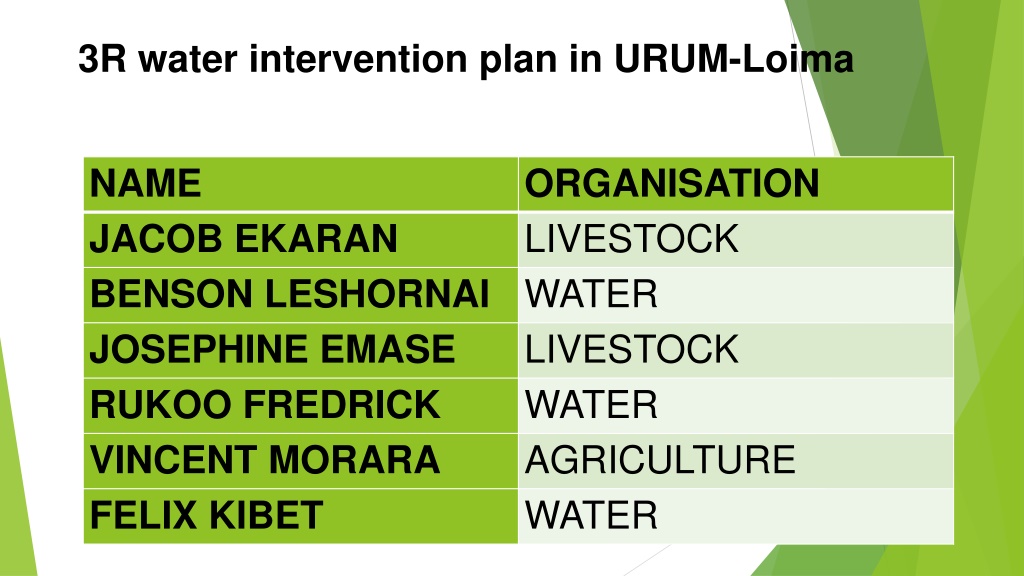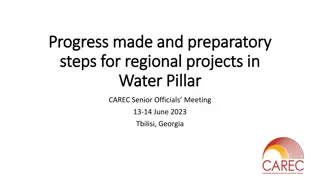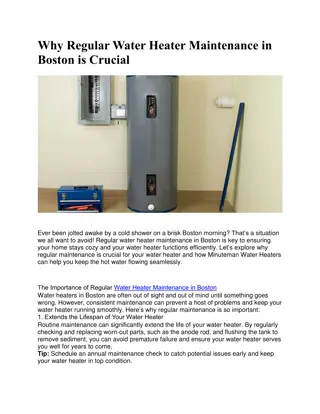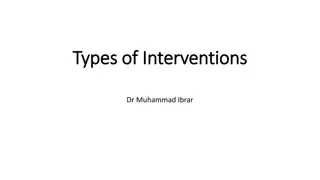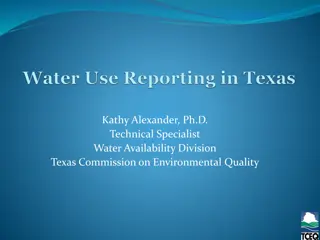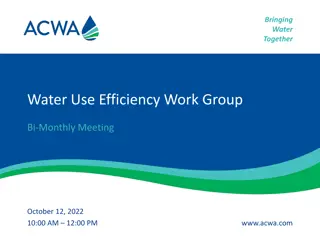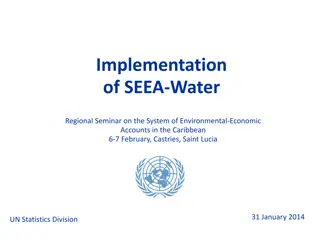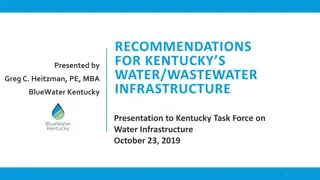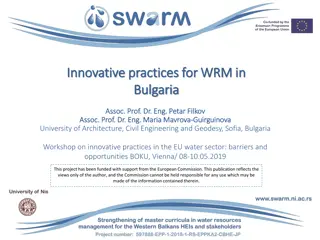Water Intervention Plan in Urum-Loima Region
This water intervention plan in the Urum-Loima region focuses on addressing water gaps and potential zones for groundwater exploration. It includes related interventions such as open water storage and sand dams to meet current and future water demands for domestic, livestock, and agricultural use. The plan identifies suitable interventions based on water user groups and intervention quantity and quality. Additionally, potential yields and costs are compared for different intervention options in the region.
Download Presentation

Please find below an Image/Link to download the presentation.
The content on the website is provided AS IS for your information and personal use only. It may not be sold, licensed, or shared on other websites without obtaining consent from the author. Download presentation by click this link. If you encounter any issues during the download, it is possible that the publisher has removed the file from their server.
E N D
Presentation Transcript
3R water intervention plan in URUM-Loima NAME JACOB EKARAN BENSON LESHORNAI WATER JOSEPHINE EMASE RUKOO FREDRICK VINCENT MORARA FELIX KIBET ORGANISATION LIVESTOCK LIVESTOCK WATER AGRICULTURE WATER
GEO REFERENCE 2057 31.76 N 34041 47.64 E
WATER GAP USERS CURRENT USE FUTURE WATER GAP (M3/Y) [YEAR] DEMAND (M3/Y) (M3/Y) [YEAR] DOMESTIC 8528 38394 29,866 LIVESTOCK 554298 599964 45,666 AGRICULTURE 545644 800072 254,428 TOTAL 1108470 1438430 329,960
3R potential zones in URUM 0A:HIGH POTENTIAL FOR GROUND WATER EXPLORATION 1A:MOUNTAINS LOW POROSITY WEATHERING PRODUCTS SUITABLE FOR STORAGE 3A:MOUNTAINS LOW POROSITY WEATHERING PRODUCTS SIUTABLE FOR STORAGE 3C:MOUNTAINS POROSITY AND WEATHERING PRODUCTS 3E:MOUNTAINS HIGH POROSITY SUITABLE FOR STORAGE 3B:FLAT TO GENTLE SLOPING LOW POROSITY SUITABLE FOR STORAGE 4D:RECENT LIMESTONE HIGH SECONDARY POROSITY SHALLOW GW POTENTIAL 5A:SPIL WITH SLOW WATER DRAINAGE OR STUGNIC PROPERTIES
RELATED INTERVENTIONS Open water storage:1A, Some potential if combined with 3B, 4D 3A, 3C,3B Sand dams:1A-very high potential,3A-high potential, 3B- some potential Sub-surface dams:1A-some potential, 3A and 3B high potential Shallow groundwater storage:1A, 3A, 3B, 3E -some potential 4D-limited potential Overland water storage:3B-SOME POTENTIAL Runoff reduction measures: 1A, 3A, 3C, 3E -some potential, 5A -some potential Hard surface water storage:1A, 3A, 3B, 3C, 3E some potential Deep groundwater storage:1A, 3A, 3B limited potential,3C, 3E some potential
Interventions Intervention group Water user group suitability 3R Intervention Quantity Quality A DAMS,WATER PANS MEDIUM LOW LIVESTOCK,AGRIC B SAND DAMS MED-HIGH LOW- HIGH ALL C SUBSURFACE DAM MED-HIGH LOW- HIGH ALL D GW STORAGE AQUIFERS LOW-MIDIUM LOW-MIDIUM LIV. E FLOOD WATER/SPATE IRRIGATION LOW-MED LOW LIV, AGRIC F SURFACE WATER STORAGE IN RIVERS LOW-MED LOW AGRICULT G ROCK CATCHMENT LOW-HIGH LOW LIV, AGRIC H GROUNDWATER ABSTRACTION MID MID-HIGH ALL
yields and costs comparison USERS [D/L/A] POTENTIAL YIELD (M3) EFFICIENC Y (U$D/M3) COSTS (U$D) 3R INTERVENTION L,A >50,000 100,000 1DAMS 2 L 25000 125000 2WATER PAN 50000 250000 5 D,L,A 3000,4=(12000 ) 15000 4=(60000) 4SAND DAM 5 L,A SPATE IRRIGATION A 1000 4=4000 2 2000 4=8000 4CHARCO DAMS A 10000(80%YIELD) 10 100000 ROCK CATCHMENT D,A 15M3/H 1=40,000 .0175 70000 BOREHOLE 2=80,000 2=140000
SUITED INTERVENTIONS TO USER GROUPS Water gap Interventions (can be MUS) Expecte d yield m3 Expected costs USD 298664SAND DAM,1borehole 92,000 200,000 DOMESTIC 1 DAM,WATER PAN,4 SAND 112,000 410,000 LIVESTOCK DAMS,SPATE IRRIGATION 45666 1DAM,4SAND DAMS,4CHARCO 156,000 408,000 AGRICULTUR DAMS,ROCK E CATCHMENT,BOREHOLESPATE IRRIGATION 254428 360,000 1,018,000 329960 TOTAL
COMMENTS Its difficult to quantify spate irrigation and thus its hard to get the cost of the intervention sand dams are used by all the user groups and so its viable and a number of them can be constructed Urum is a dry season grazing area and migratory route and therefore need to have adequate water sources
